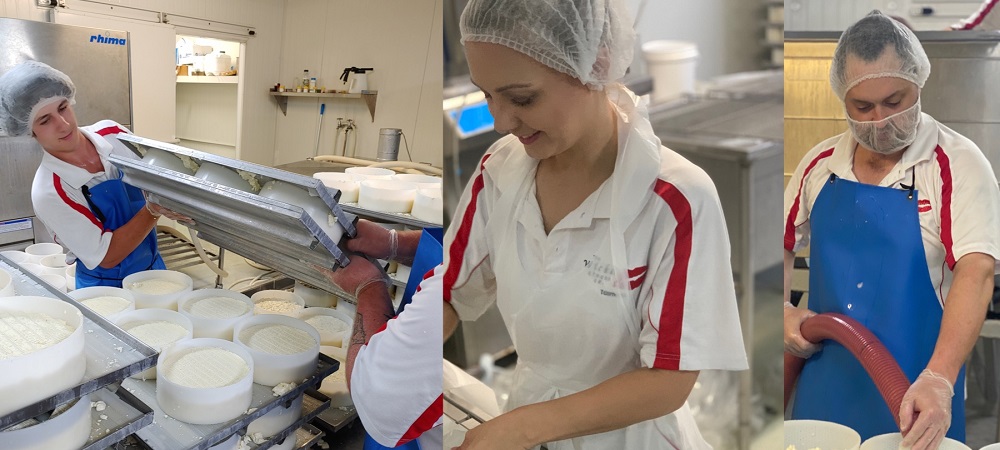Just How Floridia Cheese Melbourne Establishes the Criterion for Neighborhood Cheese Makers
Just How Floridia Cheese Melbourne Establishes the Criterion for Neighborhood Cheese Makers
Blog Article
Opening the Secrets of Artisanal Cheese Making: A Detailed Do It Yourself Guide
In the world of cooking craftsmanship, artisanal cheese making stands as a testament to the fragile balance in between tradition and advancement. Each action in the process, from choosing the appropriate milk to perfecting aging techniques, holds within it a wide range of knowledge passed down with generations. As we get started on this journey to demystify the art of producing exquisite cheeses, we are encountered with a tapestry of skills and tricks waiting to be unraveled. Join us as we explore the ins and outs of this old craft, where patience, art, and science assemble to create tastes that entice the detects.
Picking the Right Milk
When getting started on the trip of artisanal cheese making, the selection of milk plays a vital function in identifying the high quality and features of the last product. The type of milk picked affects the taste, texture, and generally account of the cheese.
When choosing milk for cheese making, it is very important to take into consideration the fat content. Higher fat web content in milk can result in a creamier and richer cheese, while reduced fat web content may bring about a drier and firmer texture. In addition, the source of the milk, whether from cows, goats, lamb, or buffalo, adds unique tastes and qualities to the cheese (Floridia Cheese Melbourne). Each kind of milk brings its own nuances, enabling a wide variety of cheese varieties to be crafted based upon the chosen milk. Eventually, the option of milk is an essential choice that establishes the structure for a successful artisanal cheese-making venture.
Culturing and Coagulating
To launch the cheese-making procedure, the critical actions of culturing and coagulating need to be very carefully carried out to change milk into curds and whey. The type of culture used can significantly impact the taste, appearance, and ripening of the final cheese product.

The timing and temperature control during culturing and coagulation are critical variables that affect the final end result of the cheese. Correct implementation of these steps is vital to make certain the preferred texture, taste, and consistency of the artisanal cheese being generated.
Draining and Pushing Curds
After the milk proteins have actually coagulated and the curds have been reduced to release whey, the following vital step in artisanal cheese making entails draining and pushing the curds to achieve the wanted texture and uniformity of the final cheese item. Draining pipes is the process of dividing the curds from the whey. This can be done by transferring the curds right into a cheesecloth-lined bowl-shaped sieve or mold and permitting the whey to drain off naturally. The time for draining can differ depending on the sort of cheese being made and the wanted moisture material.
Pressing helps remove any type of staying whey and compacts the curds to develop a solid cheese wheel. Appropriate pressing and draining pipes are essential steps that considerably affect the high quality and attributes of the artisanal cheese being created.
Aging and Flavoring Techniques
Applying precise aging and flavor methods is pivotal in improving the deepness and complexity of artisanal cheeses, boosting their taste accounts to exquisite levels of improvement and elegance. Aging plays a crucial function in creating the distinct tastes and textures that identify artisanal cheeses.
Flavoring techniques additionally contribute substantially to the last taste of artisanal cheeses. More about the author Cheesemakers may select to present additional flavors by integrating ingredients such as herbs, flavors, or perhaps fruits into the cheese during the manufacturing procedure. Additionally, some cheeses are washed or scrubed with different fluids, such as salt water or alcohol, to enhance their flavors and textures.
Wrapping and Keeping Cheeses

Conclusion
In conclusion, grasping the art of artisanal cheese making entails carefully choosing the ideal milk, adhering to precise culturing and coagulating processes, draining and pressing curds successfully, and making use of numerous aging and flavoring techniques. Keep in mind to cover and save your cheeses effectively to ensure optimal flavor and texture development.
Each type of milk brings its own nuances, allowing for a broad variety of cheese ranges to be crafted based on the selected milk.After the milk healthy proteins have actually coagulated and the curds have actually been cut to release whey, the next critical action in artisanal cheese making entails draining pipes and pushing the curds to attain the wanted appearance and uniformity of the last cheese product. Many cheeses must be wrapped in wax paper or cheese paper to allow them to breathe while safeguarding them from drying out. web For cheeses that need to proceed aging, such as bloomy peels or cleaned skins, ensure they are look what i found stored in an awesome environment like a cheese cavern or a fridge set to the appropriate temperature level. By paying focus to the covering and storage of artisanal cheeses, cheese makers and fanatics can maintain the stability of these delicacies and fully appreciate their complicated flavors.
Report this page